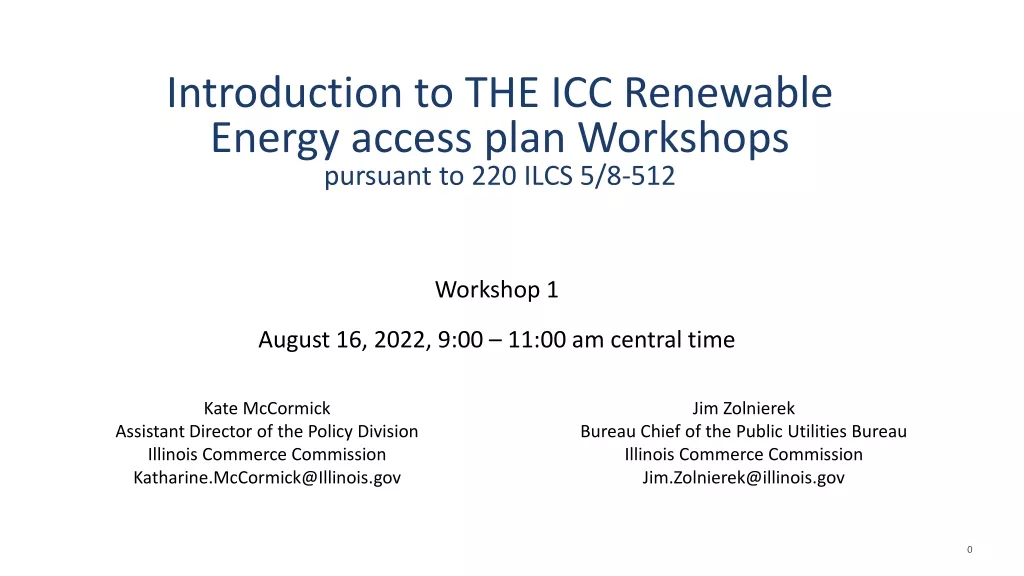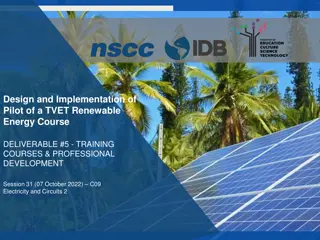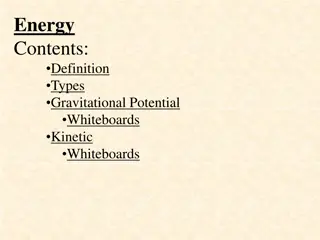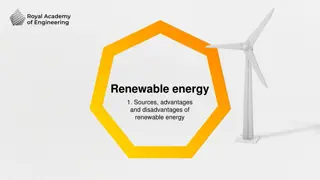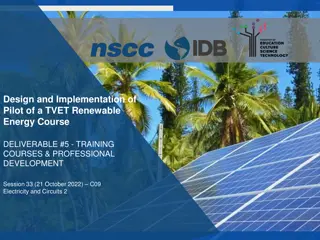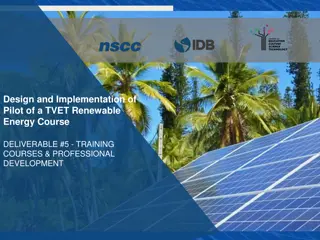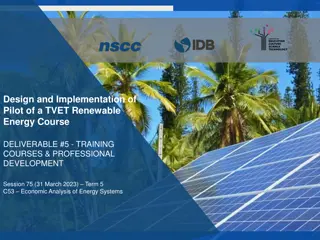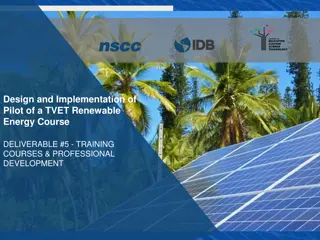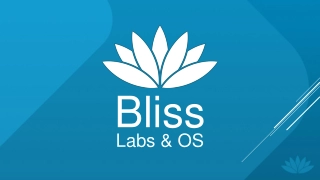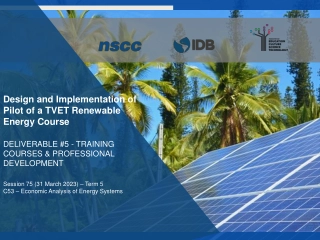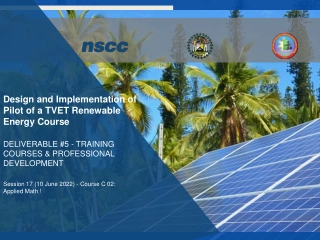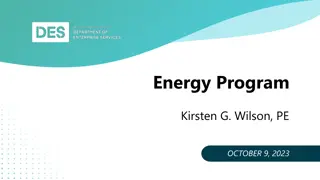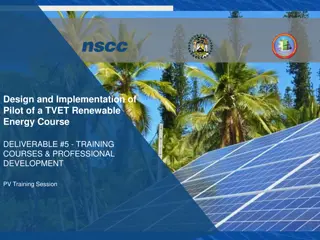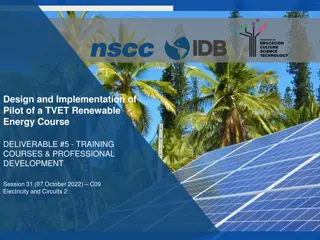Stand-Alone Labs for Renewable Energy Training Courses
Enhance practical skills in renewable energy through stand-alone labs featuring OutBack products like Mate3s System, Flexmax 80 Charge Controller, and FXR Inverter. Students learn to troubleshoot, commission, and build systems, supported by manuals and interactive procedures.
Stand-Alone Labs for Renewable Energy Training Courses
PowerPoint presentation about 'Stand-Alone Labs for Renewable Energy Training Courses'. This presentation describes the topic on Enhance practical skills in renewable energy through stand-alone labs featuring OutBack products like Mate3s System, Flexmax 80 Charge Controller, and FXR Inverter. Students learn to troubleshoot, commission, and build systems, supported by manuals and interactive procedures.. Download this presentation absolutely free.
Presentation Transcript
Design and Implementation of Pilot of a TVET Renewable Energy Course DELIVERABLE #5 - TRAINING COURSES & PROFESSIONAL DEVELOPMENT
Stand Alone Labs The OutBack products at the campus are: The Mate3s System Display and Controller The Flexmax 80 Charge Controller The FXR Inverter 3048 In the course folder there are manuals for them.
Stand Alone Labs This document / presentation is for the instructor to familiarize themselves with the equipment before getting the student to work on these labs. The mounting of the equipment (charge controller and inverter could be permanent or on a rolling rack. The first lab is using the inverter and getting to know how it is programmed and wired. The second lab is to add the charge controller and PV to complete the stand-alone system.
Stand Alone Labs These labs are the backbone for students to troubleshoot, commission and build a stand-alone system for higher wattage consumption. They are encouraged to write a procedure for each lab as if they were interacting with a customer. Tables of settings should also be developed.
Stand Alone Labs The Mate3s System Display and Controller. It is the graphical interface that allows the inverter and charge controller to be monitored and programmed. It connects via an ethernet wire / RJ45.
Stand Alone Labs MATE3 Programming home screen. https://www.youtube.com/watch?v=LEXrtPpmplI&list =PL47voUmKCsCeV5K8r5mu97B4uk7w7GZJk&ind ex=20 https://www.youtube.com/watch?v=q1DiWBQ63N8
Stand Alone Labs The first lab uses the FXR Inverter. 48V DC battery input. 3000Watts output AC pure sinewave. Two manuals, one for installation the other for operations. The Mate3s is used to program the parameters.
Stand Alone Labs AC schematic wiring for FXR Inverter. System overview.
Stand Alone Labs The FXR Inverter has many operating modes compared to other inverters of this quality. The Stand-Alone option that we will use in the labs is the Generator mode. It allows for a generator to be used to charge the battery bank. It allows AC power into it to act like a battery charger. It sends out (inverts) AC 120V from the battery.
Stand Alone Labs The labs will need the students to have the inverter mounted and wired before they can do the lab. They will also need time to read the manuals and what parameters need to be set and to what values first. The DC will be applied to the inverter before the AC is turned on. With the DC on, the Mate3s can set the mode and parameters.
Stand Alone Labs Once the DC power is on and the mate is powered up, the mate manual can be used to step through the process. You are going to need to have time before the labs to be able to teach the students about the mate3.
Stand Alone Labs The first lab is to get the students to wire up the inverter to the batteries. There needs to be DC and AC breakers, a ground to the campus ground. An AC panel or a power bar is an option to connect loads to the inverter. The students will be able to torque the connections, the torque values are in the manual. You will need a resistive load and an inductive load, small motor.
Stand Alone Labs A big part of the learning using these pieces of equipment is knowing how parameters work. Having them understand those parameters before the lab is important. The complete list of the parameters are in table 25 of the operation manual. Having the students select them for this lab is important.
Stand Alone Labs Where there is only one inverter, having each student program at least one parameter is important. Maybe divide the class into 4 groups to work on selecting the values for each parameter. Then have them come together to explain their choices. Make them draw up a list of the parameters that need to be set and have them in an order that they will perform sequentially.
Stand Alone Labs The Hot Key are turn off or on settings. Where there is no AC grid the charger function is turned off. (Yellow Highlighted is recommended) AC input mode needs to be Drop turned off. The Search feature is explained as the inverter turns off but checks to see if a load is present. If there is a load the inverter starts.
Stand Alone Labs The Search options can be explored by the students, and they can decide on the settings. Input type is not Grid, so only other option is Gen. We are not using any AC source, so Charge Control is turned Off.
Stand Alone Labs The Mode is set here by selecting Generator. None of the other parameters are important as we are not connecting a generator to the inverter.
Stand Alone Labs The X indicates that this is the default setting of 120Vac. It can be adjusted within the range of 100 and 130. Might be a good exercise during the lab. The other settings can be researched by the students and let them explain their choices for them. The FULLRIVER manual suggests values based on DoD.
Stand Alone Labs The Auxiliary relay output contact can be set and the Vent Fan option can be set to a value that the students can make it turn it on and off by adjusting the voltage range. A multimeter on ohms can test the state of the relay contacts. No fan is required for this.
Stand Alone Labs Master Power Save Level appears on an inverter which is set as master (the default setting). The range of rank numbers is 0 to 10. The default value is 0. The master is normally left at this value. The Master Power Save Level function is used for the master inverter on Port 1. Slave Power Save Level appears on an inverter which is set as slave. The range of rank numbers is 1 to 10. (The default value for all ports is 1.
Stand Alone Labs Master Power Save Level appears on an inverter which is set as master (the default setting). The range of rank numbers is 0 to 10. The default value is 0. The master is normally left at this value.
Stand Alone Labs If the model begins with a V it is vented.
Stand Alone Labs Before the students get ready to use the inverter, calculate the resistive load to have it fall into the C-20 rate. The 105Ahr at 20 hours will have 5.3A being pulled from the battery. There are 34 watts being used by the inverter. 34 Watts at 50volts = .7Amps An AC load needs to draw 5.3 - .7A = 4.6A from the battery.
Stand Alone Labs 4.6A x 50Volts = 230W. A 200Watt resistive load ( 2 100Watt incandescent light bulbs) or equivalent will work. The batteries should drain at the C-20 Rate and the students should see this. They need to measure the time the load is on the inverter. The batteries will seem lower under this draw, but will be more accurate after they are removed from the load.
Stand Alone Labs Once the students understand the parameters and have the table made with the settings they want to use. They can turn on the inverter with the toggle switch mentioned in the lab writeup. Once the inverter is on and inverting, the students can make current and voltage measurements at the battery. They can also measure the AC voltage out and if the output needs to be calibrated, they can do that now.
Stand Alone Labs The SoC of the battery bank can be calculated at this point. Apply a resistive load and measure the same reading before the load was applied. After 5 minutes take another measurement. Continue to do so until the DoD can be calculated. Are the batteries performing as expected?
Stand Alone Labs Remove the resistive load and allow the batteries to level out. The SoC of the battery bank can be calculated at this point. Apply an inductive load to the inverter. Measure the VA and the battery reading of current and voltage. The battery Wattage should be less than the VA of the load. The inverter is supplying the VARs required for the motor or inductive load.
Stand Alone Labs After everyone is satisfied with the readings. Remove the inductive load and allow the batteries to level out. The SoC of the battery bank can be calculated at this point. The students will have the inverter running load, various battery measurements. They should be able to measure the SoC as the resistive load was operated.
Stand Alone Labs Comparing the SoC and the rate of discharge the batteries experienced. The students can compare against the C-Rates provided by the battery manufacturer. The batteries under load will be lower than they actually are when the load is removed.
Stand Alone Labs The second lab involves connecting the FLEXmax charge controller to charge the batteries. The calculation for the string size has been completed in the Stand-Alone presentation. The array will consist of the four 395Watt PV modules. 2 strings of two modules series.
Stand Alone Labs A combiner box will be used, and the four trainers will be taken outside and connected in this configuration. The charge controller shall be mounted next to the inverter and batteries. The PV output circuit can use wires long enough to go from outside to inside to where the inverter and charge controller are located. The last lab can stay connected as it was.
Stand Alone Labs The FLEXmax 80 charge controller is rated for an input of 150Volts (140Volts working) from a PV array at 80 Amps. Has the following features: Supports 12, 24, 36, 48, and 60 Vdc battery voltages. Backlit LCD display screen with 80 characters (4 lines, 20 characters per line). Last 128 days of operational data are logged for review. Voltage step-down capability allowing a higher PV array voltage configuration.
Stand Alone Labs Built in screen, no need for the Mate3s. Some soft keys will be used for navigation. Some soft keys will be used for programming.
Stand Alone Labs Soft key functions are identified by text in the LCD screen directly above the key (e.g., EXIT). In this manual, soft keys will be identified by brackets (for example, <EXIT>). Not every soft key may be used in some screens.
Stand Alone Labs The FLEXmax is intended to be bonded to ground, like the inverter is. DC / Battery-Related Installation Requirements Shut off all DC circuit breakers before connecting any wiring. Torque all the FLEXmax wire lugs and ground terminals to 4 Nm (35 in- lb). Copper wiring must be rated at 75 C or higher. Use up to 35 mm2 (2 AWG) to reduce losses and ensure highest performance of the FLEXmax.
Stand Alone Labs Smaller cables can reduce performance and possibly damage the unit. Run positive and negative cables side by side. Keep cables together as much as possible to allow the inductive currents to cancel. Ensure paired cables pass through the same knockout and conduit fittings. DC battery overcurrent protection must be used as part of the installation. OutBack offers both circuit breakers and fuses for overcurrent protection.
Stand Alone Labs Wiring compartment of the FLEXmax.
Stand Alone Labs Wiring of the charge controller to battery and PV including shunt if available. The inverter is not shown here, but can be connected as the arrows indicate. Negative of inverter to negative bus. Positive of inverter to breaker (same as It was. A common connection at battery.
Stand Alone Labs Wiring of the charge controller to battery and PV including shunt if available. Please note that the connection of the PV array is not the same as used for this lab. A HUB 4 is required if the Mate3 is used by both the inverter and charge controller.
Stand Alone Labs Operation of this unit consists of monitoring screens and programming screens. The majority of programming screens are accessed using the main menu. The FLEXmax uses power from the battery bank to operate. The battery voltage must be at least 10.5 volts or higher to power up the FLEXmax. When battery power is detected, the FLEXmax will go through a series of power-up screens.
Stand Alone Labs When the FLEXmax first powers up these instruction must be completed. The digital manual is part of the course pack.
Stand Alone Labs The FLEXmax uses three stage charging. The bulk starts as soon as the sun powers up the PV array. The MPPT should start and put as much into the battery as possible. These are the 48volt settings from FULLRIVER.
Stand Alone Labs The recommended bulk current is 20-25% of the 20 Hr AH capacity or 0.20 x C20 (20 Hr. capacity in AH). The maximum allowable bulk current is 35% of the 20 Hr. AH capacity or 0.35 x C20 (20Hr. capacity in AH), unless specified. DC115-12 is rated at 105AH @ 20 Hrs. The recommended bulk current is 0.20 x 105 = 21 Amps The maximum bulk current is 0.35 x 105 = 36.8 Amps.
Stand Alone Labs The array consists of four 395W modules. With MPPT, the total wattage is 1580Watts. Bulk amperage will depend on the voltage of the battery bank. Worst case is the bank is at 42 Volts (0% SoC). The available PV amperage is 1580W / 42V = 37.6A
Stand Alone Labs This is very close to the maximum of 40A that the battery should be charged with. This scenario can happen if the PV is turned on during the day and the charge controller goes into Bulk stage charging. The charge controller should be programmed to limit the Bulk charge to a lower value. The recommended bulk current is 21Amps. This is a good exercise for the students to do.
Stand Alone Labs If there is a load applied to the inverter, it will require amperage as well. This extra amperage will take away from the bulk available current to charge the batteries. If the load is known and repeated everyday, then the Bulk current can be increased. The maximum available from the array is close to 40A.
Stand Alone Labs This is the Main Menu screen.
Stand Alone Labs Charger Screen: Charging settings should follow the battery manufacturer s recommendations. This screen allows changes to the recharging voltage set points if the default settings do not match the battery manufacturer's recommendations.
Stand Alone Labs (For an explanation of battery charging, see pages 98 and 99). Current Limit Absorbing Float The default charger output current limit setting is: 80 amps for the FM80. This setting is adjustable from 5 to 80 amps
Stand Alone Labs Absorb Time Limits (Advanced Menu) The amount of time the charge controller stays in the Absorbing stage of charging can be adjusted in the Absorb Time Limits screen. An Absorbing charge stage normally ends when the battery voltage is maintained at the Absorbing set point for the time period set in the Absorb Time Limits screen. Absorb Time is adjustable from 0 to 24 hours (consult the battery manufacturer s recommendations). See upcoming slides for this calculation.






